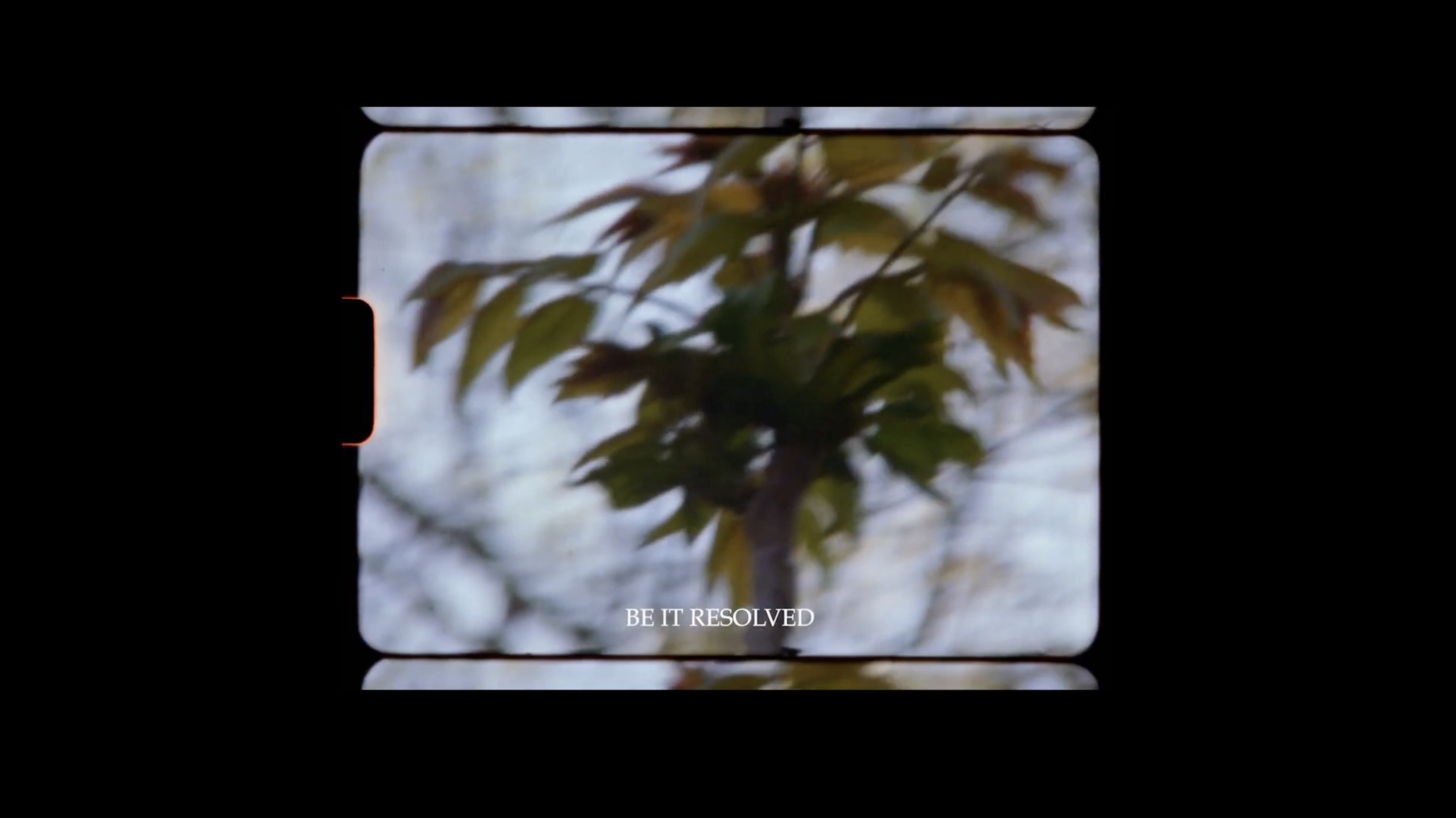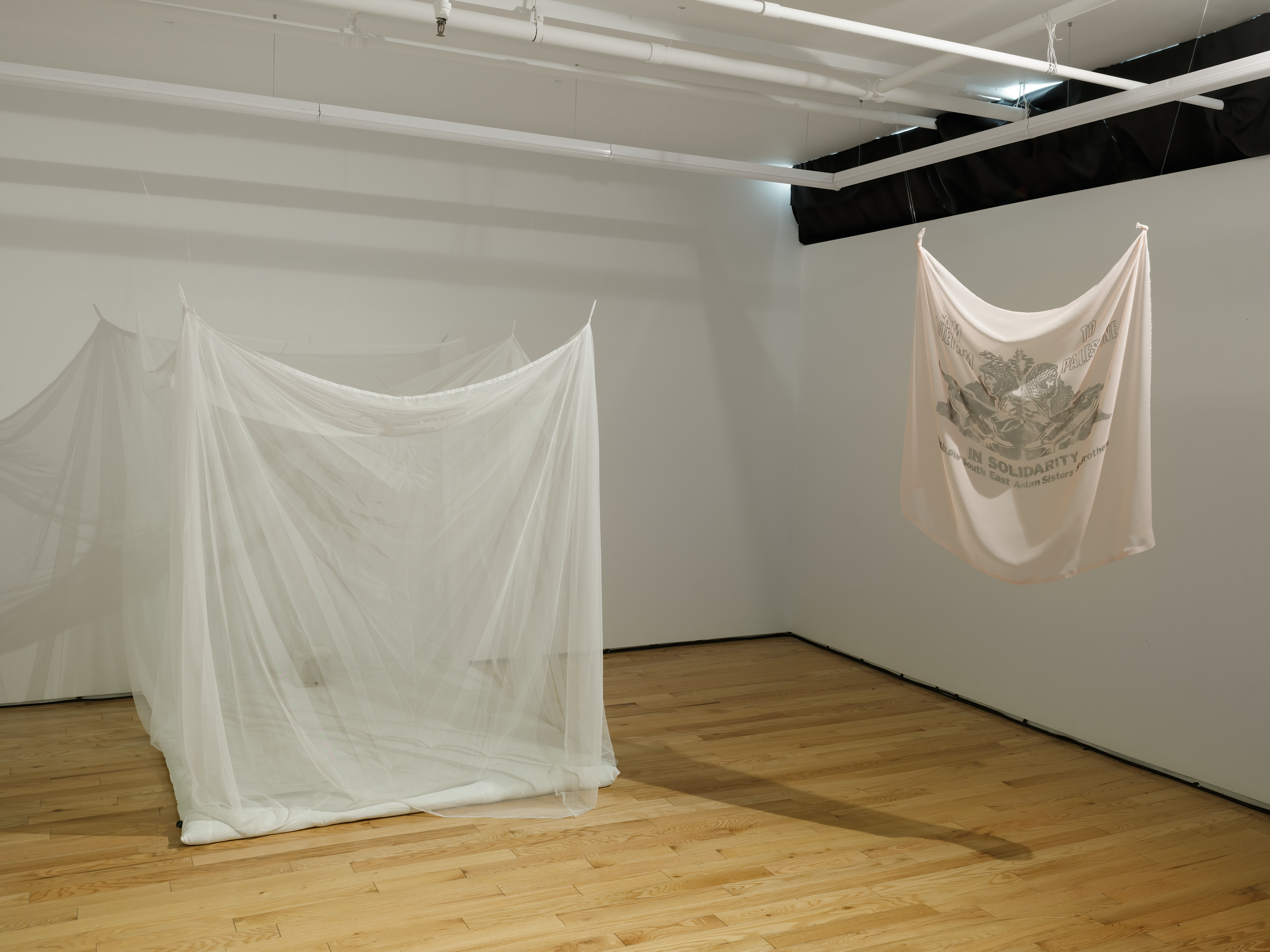formerly: Rubber Factory
full archive here
full archive here
If you can hear the sound of my voice, clap once
Hông-Ân Trúóng
September 06 – October 19, 2024





island is pleased to present Hông-Ân Trúóng’s latest solo exhibition, If you can hear the sound of my voice, clap once. This is the artist’s second solo presentation with island, following We Are Beside Ourselves, exhibited in 2018. In this latest body of work, Hông-Ân Trúóng develops upon a sustained practice of integrating historical ephemera into multimedia installations, drawing together sound, film, and fabric works in order to examine the Third World Liberation struggle and the antiwar movement against colonial violence in Việt Nam, as well as the anti-colonial liberation movement in Palestine during the 1960s, 70s, and today.
In Trúóng’s seven channel sound installation, audio recordings of speeches, protests, chants, and interviews are excerpted from historical archives that include the UC Berkeley Comparative Ethnic Studies Archive, The Freedom Archives, and the Anti-Imperialist Archive, as well as recordings from recent anti-war campus protests against the ongoing Israeli state and settler violence against Palestinians. The densely layered and highly charged excerpts, many of which respond to U.S. police violence and are focused on the protest practice of call and response, intertwine with traditional Vietnamese drumming. Sound transfigures from an aural material to one that is tangible, grounding the listener in both the past and present. A cacophony of rhythmic voices swell, echo, and subside, raising questions about legibility and illegibility regarding political voices and speech. In one channel, the accented voice of H.K. Yuen, the San Francisco community member who recorded thousands of hours of material documenting social movements of the 1960s and 70s, quietly narrates what he is witnessing as protesting students at UC Berkeley march through campus trying to avoid confrontation with the police. Trúóng directs us to the foundation of decolonization as simply listening: intentional and decentered listening that reveals pathways towards solidarity and collective subjectivity. The practice requires a destabilization of the self and attempts to use sonic diffusion as a means of orienting ourselves towards new, more just paradigms.
The exhibition also presents a silent short film by Trúóng featuring two of the artist’s own friends and fellow activists, Nadeen Bir and Ngọc Loan Trần. In the video work, Trúóng captures mundane, intimate, and ritualistic interactions between them. We see Bir, who is Palestinian, and Trần, who is Vietnamese, engage in conversation as the camera focuses on close up shots of their exchanges. What we cannot hear we are able to witness through their gestures, as an anchor to the sounds of protest and speech that emanate from the other room: joy and resistance that materialize in everyday moments. The film functions as a hybrid essay poem, also featuring an excerpt of writing by Trần. Ultimately, the film and the exhibition engages us in the power of transmission – both auditory and narrative – part of the searching struggle for embodied truths and unflinching honesty about our histories, demanding something beyond a sterilized dialectic of violence and anti-violence.
The multimedia installation incorporates material that is charged with cultural memory. Trúóng utilizes objects that resonate with Vietnamese culture. Mosquito nets drape over futon mats laid on the ground. They suggest domestic space, creating small, intimate shelters that invite viewers to engage in the vulnerability that it takes to remove one’s shoes, lie or sit down, and listen quietly. To experience this work is to enter it. Silk fabric embedded with protest movement imagery, also extracted from historical archives, hangs throughout the space. Her process of transferring and layering these pieces of history is a physical gesture towards the methodological intertwining that she amplifies with this work. In hues of white and pink, archival imagery of unnamed activists, protestors, and poster graphics are fused across the fabric. In one, taken from an Arabic and English language poster, ghostly photographs of two women being restrained by police mirror each other, one in colonial Việt Nam and the other in colonial Palestine. In another piece, pages of the AAPA newspaper depict crowds of Asian protesters marching against the U.S. war in Việt Nam. These narratives of global solidarity point us to radical history-making and possible collective planetary futures.
Hông-Ân Trúóng uses photography, video, and sound to explore immigrant, refugee, and decolonial narratives and subjectivities. Her work has been shown in group exhibitions at the ICP(NY), the Nasher Museum of Art (Durham, NC), The Kitchen (NY), Nhà Sàn (Hanoi), the Irish Museum of Modern Art (Dublin), the Phillips Collection (Washington D.C), and the Museum of Modern Art (NY). Her work was included in the New Orleans triennial Prospect.4 in 2018. She was a Guggenheim Fellow in 2019-2020, the Capp St. Artist in Residence at the Wattis Institute for Contemporary Art in 2020, and a MacDowell Residency Fellow in 2022. Her writing has appeared in the Brooklyn Rail, Shifter Magazine, and most recently in Best! Letters from Asian Americans in the Arts, published by Paper Monument in 2021, and in American Art in Asia: Artistic Practice and Theoretical Divergence, edited by Michelle Lim and Kyunghee Pyun, published by Routledge in 2022. She recently launched two web-based projects during the pandemic, Return to the Source, with denisse and rade, and We Listen Nearby, as part of her Wattis residency. Hông-Ân lives in Durham, North Carolina where she is an activist and a teacher. She is a professor at the University of North Carolina at Chapel Hill.
In Trúóng’s seven channel sound installation, audio recordings of speeches, protests, chants, and interviews are excerpted from historical archives that include the UC Berkeley Comparative Ethnic Studies Archive, The Freedom Archives, and the Anti-Imperialist Archive, as well as recordings from recent anti-war campus protests against the ongoing Israeli state and settler violence against Palestinians. The densely layered and highly charged excerpts, many of which respond to U.S. police violence and are focused on the protest practice of call and response, intertwine with traditional Vietnamese drumming. Sound transfigures from an aural material to one that is tangible, grounding the listener in both the past and present. A cacophony of rhythmic voices swell, echo, and subside, raising questions about legibility and illegibility regarding political voices and speech. In one channel, the accented voice of H.K. Yuen, the San Francisco community member who recorded thousands of hours of material documenting social movements of the 1960s and 70s, quietly narrates what he is witnessing as protesting students at UC Berkeley march through campus trying to avoid confrontation with the police. Trúóng directs us to the foundation of decolonization as simply listening: intentional and decentered listening that reveals pathways towards solidarity and collective subjectivity. The practice requires a destabilization of the self and attempts to use sonic diffusion as a means of orienting ourselves towards new, more just paradigms.
The exhibition also presents a silent short film by Trúóng featuring two of the artist’s own friends and fellow activists, Nadeen Bir and Ngọc Loan Trần. In the video work, Trúóng captures mundane, intimate, and ritualistic interactions between them. We see Bir, who is Palestinian, and Trần, who is Vietnamese, engage in conversation as the camera focuses on close up shots of their exchanges. What we cannot hear we are able to witness through their gestures, as an anchor to the sounds of protest and speech that emanate from the other room: joy and resistance that materialize in everyday moments. The film functions as a hybrid essay poem, also featuring an excerpt of writing by Trần. Ultimately, the film and the exhibition engages us in the power of transmission – both auditory and narrative – part of the searching struggle for embodied truths and unflinching honesty about our histories, demanding something beyond a sterilized dialectic of violence and anti-violence.
The multimedia installation incorporates material that is charged with cultural memory. Trúóng utilizes objects that resonate with Vietnamese culture. Mosquito nets drape over futon mats laid on the ground. They suggest domestic space, creating small, intimate shelters that invite viewers to engage in the vulnerability that it takes to remove one’s shoes, lie or sit down, and listen quietly. To experience this work is to enter it. Silk fabric embedded with protest movement imagery, also extracted from historical archives, hangs throughout the space. Her process of transferring and layering these pieces of history is a physical gesture towards the methodological intertwining that she amplifies with this work. In hues of white and pink, archival imagery of unnamed activists, protestors, and poster graphics are fused across the fabric. In one, taken from an Arabic and English language poster, ghostly photographs of two women being restrained by police mirror each other, one in colonial Việt Nam and the other in colonial Palestine. In another piece, pages of the AAPA newspaper depict crowds of Asian protesters marching against the U.S. war in Việt Nam. These narratives of global solidarity point us to radical history-making and possible collective planetary futures.
